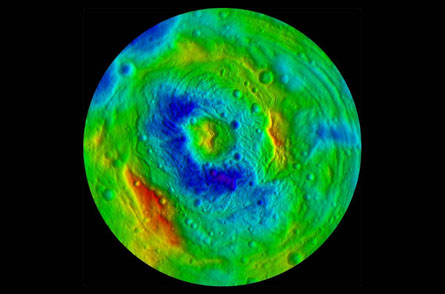NANTES, France — Vesta might be a planetary runt, but it holds bragging rights to one of the solar system’s highest peaks.

Rising 20 kilometers from the floor of an enormous impact basin in the asteroid’s south pole, Vesta’s massif is taller than Hawaii’s Mauna Kea — Earth’s highest mountain when measured from the bottom of the ocean. Vesta’s peak is still smaller than the solar system’s reigning giant, a Martian volcano called Olympus Mons. But then, Vesta is only 530 kilometers in diameter to Mars’ 6,800 kilometers. Scientists haven’t named the protrusion yet, but the crater is named Rheasilvia, after the mythological mother of the twins who founded Rome.
Chris Russell, principal investigator of NASA’s Dawn mission, says he now considers Vesta the smallest terrestrial planet in the solar system. “Like Earth, Mars, Venus and Mercury, Vesta has an ancient basaltic crust, lava flows going across the surface, and it also has a large iron core,” he says. “It has tectonic features, like on Earth: rift valleys, ridges, cliffs, hills and a giant mountain.”
These and other new results from the Dawn spacecraft, which has been circling Vesta since mid-July, were presented October 3 during a joint meeting of the American Astronomical Society’s Division of Planetary Sciences and the European Planetary Science Congress.
Dawn recently completed a survey orbit that peered down upon Vesta’s rough surface from 2,700 kilometers up. The data show that Vesta’s surface composition is highly varied. The heavily cratered northern surface appears to be older than the smoother southern surface by several billion years, says Nico Schmedemann of the Free University of Berlin, Germany, who presented evidence suggesting that the asteroid’s northern surface is just shy of 4 billion years old, but that the south pole basin could be a spry 2.5 billion years old.
These estimates are likely to change and are much younger than Vesta’s estimated age, which scientists think is closer to 4.5 billion years old. With a more precise analysis, it’s likely the team’s estimate will become older, says Bill Bottke of the Southwest Research Institute in Boulder, Colo.
But, he notes, “It seems reasonable that we have a Vesta surface which is a combination of fairly young terrain, and also very ancient terrain.”







